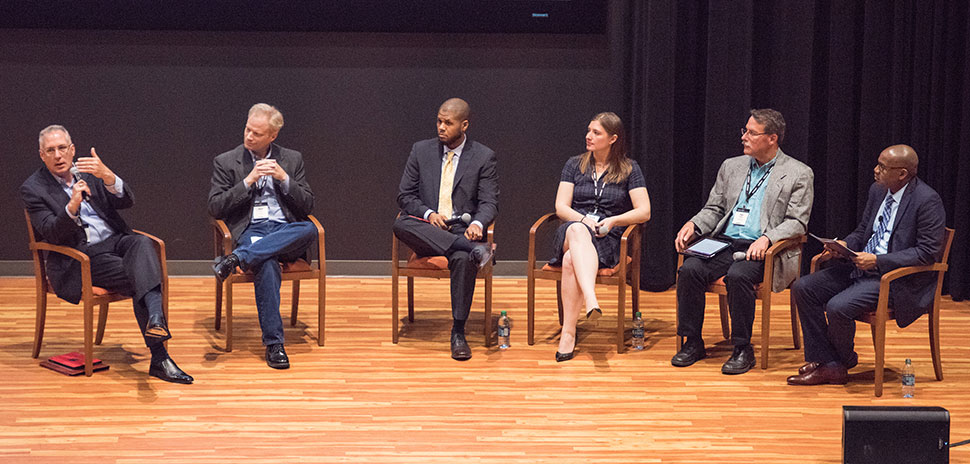![]() Flying cars, self-sustained electric grids, and autonomous cars aren’t just fantasies — they could all transform the world in the next eight years.
Flying cars, self-sustained electric grids, and autonomous cars aren’t just fantasies — they could all transform the world in the next eight years.
These bold predictions were the focus of the 2025 Visionaries Roundtable discussion Tuesday during the North Texas Smart Cities Summit at the University of Texas at Dallas.
The full-day event brought together industry experts, academicians, city leaders, and more to discuss the smart cities movement on a city and regional level.
“You have to think and behave like you’re an entrepreneur inside the industry.”
Kevin Saye
The key is to fail fast, continue experimenting, and embrace new transformative technologies.
“You have to forget about those things that brought you here today,” said Kevin Saye, an IoT technical expert at Microsoft. “You have to think and behave like you’re an entrepreneur inside the industry. How have you transformed the world? Those organizations who resisted change probably aren’t here today or are under huge scrutiny right now.”
FLYING CARS?
The flying cars first envisioned in the 1960s cartoon, The Jetsons, are not that far off, said Mike McNair, engineer and team lead with Bell Helicopter, which is working on propulsion technology for electric vertical takeoff and landing aircraft.
The Fort Worth-based aircraft manufacturer has partnered with Uber to develop on-demand VTOL aircraft, which the ride sharing company plans to test by 2020 in the Dallas area.
McNair said the biggest challenge for flying vehicles isn’t the technology — it’s licensing, insuring, training, and infrastructure.
“What kind of training goes into that?” McNair asked. “What skills and competencies are needed? Looking at the range of possible people that could benefit from it, it can go anywhere from a VIP to emergency medical services, or someone who wants to escape commuter traffic.”
And there are even more questions to be answered.
Where will they land and take off? Who will enforce traffic laws in the sky? Will they be autonomous? Will they run on fossil fuels or electricity?
“We’re taking that kind of leap between mobile phones to what comes next in 2025. Everyone expects the rate of change to be just as strong.”
Mike McNair
“By 2025 we’re going to have to understand that,” McNair said. “We’re taking that kind of leap between mobile phones to what comes next in 2025. Everyone expects the rate of change to be just as strong. So we need to acknowledge the fact that change is tough.”
With more autonomous vehicles, that means fewer personal vehicles and less space dedicated to parking.
That would free up large parking lots for totally different uses, McNair said.
MICROGRIDS COULD LESSEN POWER OUTAGES
The rise of solar power, battery storage, and other renewable energy could mean an end to most power outages and blackouts, said Michael Quinn, chief technology officer for Oncor.
Oncor calls them microgrids because they have the ability to be self-sufficient when the larger electric grid goes down. Severe weather such as tornadoes and strong winds cause anxiety for critical infrastructure such as data centers.
“They say, ‘The value of our product is so great that the two hours of outage that we’re going to have in a year is going to cost us substantially,’” Quinn said. “They can’t even take a minute of downtime.”
The rise of lithium ion batteries in electric vehicles could revolutionize on-site storage.
“It will be a big part of what we do,” Quinn said. “Think about short-term outages being a thing of the past.”
MAKING CITIES SMARTER
Downtown Dallas has about 10,000 people living in it now with more high-rise apartments and condominiums coming soon. To prepare for that influx of people, the Dallas Innovation Alliance needs to think outside the box.
The nonprofit is transforming the West End of downtown Dallas with a touchscreen kiosk, LED lighting, and other technology that taps into the internet of things.
“The demand and amenities that are necessary to support that population are very different than what’s in place in downtown,” said Jennifer Sanders, executive director of the Dallas Innovation Alliance.
“The benefit of what you’re doing is greater than the risk.”
Jennifer Sanders
Living in a world where everything is connected and talks to each other can also be scary because it gives away so much personal information.
“The benefit of what you’re doing is greater than the risk,” Sanders said. “Most people don’t know they’ve signed away and given away so much anyway.”
Connected cars don’t require 100-percent buy-in, just a small percentage of the driving public could provide a wealth of knowledge for traffic management and fleets of trucks, said James Garland, team leader for transportation and capacity planning for the U.S. Department of Transportation.































